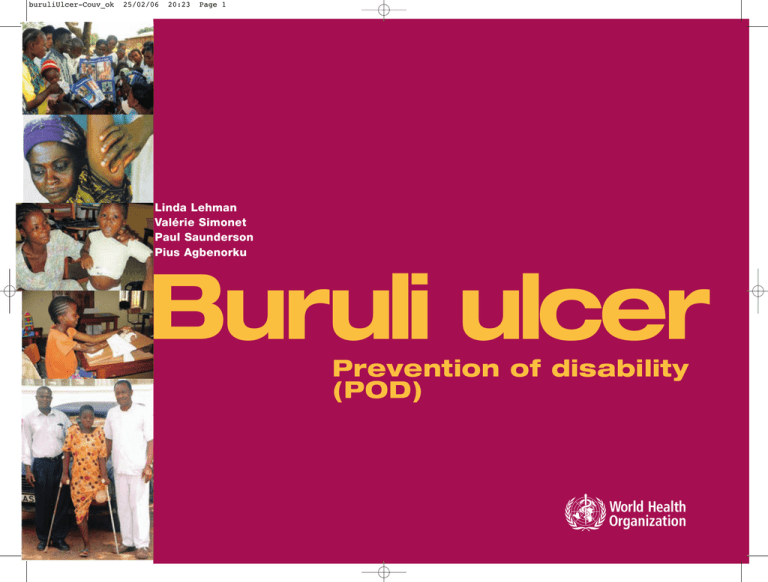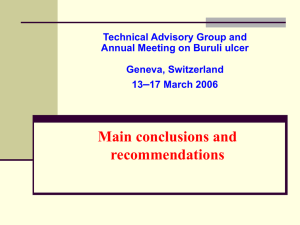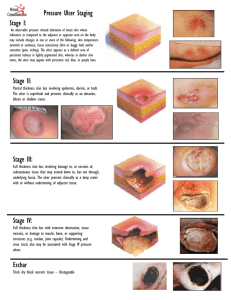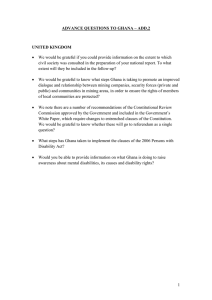
buruliUlcer-Couv_ok
25/02/06
20:23
Page 1
Linda Lehman
Valérie Simonet
Paul Saunderson
Pius Agbenorku
Buruli ulcer
Prevention of disability
(POD)
buruliUlcer-Couv_ok
25/02/06
20:23
Page 2
WHO Library Cataloguing-in-Publication Data
Buruli ulcer: prevention of disability (POD) / Linda Lehman ... [et al.].
1. Mycobacterium infections, Atypical – complications. 2. Rehabilitation. 3. Mycobacterium infections, Atypical – prevention &
control. I. Lehman, Linda. II. World Health Organization.
ISBN 92 4 154681 6
(NLM classification: WC 302)
WHO/CDS/NTD/GBUI/2006.12
© World Health Organization 2006
All rights reserved. Publications of the World Health Organization can be obtained from WHO Press, World Health Organization,
20 Avenue Appia, 1211 Geneva 27, Switzerland (tel: +41 22 791 2476; fax: +41 22 791 4857; email: bookorders@who.int). Requests
for permission to reproduce or translate WHO publications – whether for sale or for noncommercial distribution – should be addressed
to WHO Press, at the above address (fax: +41 22 791 4806; email: permissions@who.int).
The designations employed and the presentation of the material in this publication do not imply the expression of any opinion
whatsoever on the part of the World Health Organization concerning the legal status of any country, territory, city or area or of its
authorities, or concerning the delimitation of its frontiers or boundaries. Dotted lines on maps represent approximate border lines
for which there may not yet be full agreement.
The mention of specific companies or of certain manufacturers’ products does not imply that they are endorsed or recommended
by the World Health Organization in preference to others of a similar nature that are not mentioned. Errors and omissions excepted,
the names of proprietary products are distinguished by initial capital letters.
All reasonable precautions have been taken by WHO to verify the information contained in this publication. However, the published
material is being distributed without warranty of any kind, either express or implied. The responsibility for the interpretation and
use of the material lies with the reader. In no event shall the World Health Organization be liable for damages arising from its use.
The named authors [or editors as appropriate] alone are responsible for the views expressed in this publication.
Design: Bruno Duret/André Yanelle
buruliUlcer_ok
26/02/06
0:11
Page i
Buruli ulcer
Prevention of disability
(POD)
Linda Lehman
Occupational Therapist and POD/Rehabilitation Consultant to American Leprosy Missions
for the Americas and Africa, USA/Brazil
Valérie Simonet
Occupational Therapy Consultant to Aide Aux Lépreux Emmaüs Suisse, Bern, Switzerland
Paul Saunderson
Medical Consultant, American Leprosy Missions, Greenville, South Carolina, USA
Pius Agbenorku
Consultant Plastic Surgeon/Senior Lecturer, Komfo Anokye Teaching Hospital, School of
Medical Sciences, Kwame Nkrumah University of Science and Technology, Kumasi, Ghana
buruliUlcer_ok
ii
25/02/06
22:06
Page ii
buruliUlcer_ok
25/02/06
22:06
Page iii
Objectives of this manual
Health workers should be able to use this manual to:
I
I
I
I
I
I
I
understand the importance of an early prevention of disability (POD)
identify and document the person’s problems
determine interventions based on identified problems
provide the needed interventions in order to prevent or minimize disability
teach the person affected by Buruli ulcer and the family how to do self-care
monitor the response to the intervention and modify as needed
refer to other specialized services
Target groups for this manual
Implementing POD
GROUP l – Health workers starting to practice
some POD activities who need a theoretical basis
for POD, plus practical guidelines that will help them
do a better job and avoid common mistakes.
The manual will be most helpful if it is used in conjunction with a participatory method of training to
develop knowledge and skills.
GROUP 2 – People who provide supervision and
training of others in POD.
Periodic supervision will be the key to assuring that
POD activities are developed and appropriately
implemented.
GROUP 3 – Programme managers at various levels
who need to understand that POD services are an
essential component in the correct management
of Buruli ulcer, even if they are not themselves
practitioners.
POD should be integrated within the relevant training
and supervision programmes. Specialized POD training
can be introduced when health workers have participated in general Buruli ulcer control workshops and
have worked with persons affected by Buruli ulcer.
iii
buruliUlcer_ok
25/02/06
22:06
Page iv
Acknowledgements
CONTRIBUTIONS
I Mr Bismark Ofori Addo, National Buruli Ulcer Control Programme, Accra, Ghana (deceased)
I Mr Sampson Adjei, Agogo Presbyterian Hospital, Asante-Akim North, Ghana
I Dr Julien Aké Aké, MAP International, Côte d’Ivoire
I Mr Kingsley Adumata, Juaso District Hospital, Asante-Akim North, Ghana
I Mrs Margaret Agbenorku, Global Evangelical Mission Hospital, Apromase, Ghana
I Dr Edwin Ampadu, National Buruli Ulcer Control Programme, Accra, Ghana
I Mr Isaac Ansong, Bekwai Government Hospital, Ashanti, Ghana
I Dr Maria Aparecida de Faria Grossi, UFMG, Brazil
I Ms Agnes Appiah, Nyinahin Government Hospital, Ashanti, Ghana
I Dr Kingsley Asiedu, Global Buruli Ulcer Initiative, World Health Organization, Geneva, Switzerland
I Mr Edward Kwabena Brobbey, Ashanti Regional Health Administration, Kumasi, Ghana
I Mr Emmanuel Debrah, Agogo Presbyterian Hospital, Asante-Akim North, Ghana
I Ms Vivian Gozah, Global Evangelical Mission Hospital, Apromase, Ghana
I Mr Samuel Gyamfi, Korle-Bu Teaching Hospital, Accra, Ghana
I Mrs Margaret A. Karikari, Komfo Anokye Teaching Hospital (KATH), Kumasi, Ghana
I Ms Vida MacCarthy, Nkawie-Toase Government Hospital, Ashanti, Ghana
I Mr Charles Mensah, St. John of God Hospital, Duayaw-Nkwanta, Brong-Ahafo, Ghana
I Dr Federico Montero, Disability and Rehabilitation Team, World Health Organization, Geneva, Switzerland
I Mr Simon K. Tieku, Komfo Anokye Teaching Hospital, Kumasi, Ghana
I Mr Lawrence G. Tuuli, Agogo Presbyterian Mission Hospital, Agogo, Ghana
I Ms Corrianne van Velze, OTASA, Pretoria, South Africa
PHOTOS AND ILLUSTRATIONS
by: Linda Lehman
Copyrighted exercise designs with permission of: Visual Health Information (VHI)
Additional contributions
I Photo in Figure 2.1 of oedematous plaque with beginning ulceration by Paul Saunderson.
I Photo in Figure 3.1 on participation in sports by Brenda Davidson.
I Photo in Figure 5.1.6 of person affected by Buruli ulcer with a leg amputation by Charles Mensah.
I Photo in Figure 5.1.7 of man with Buruli ulcer lesion by Eric Bafende.
I Wound-healing illustrations in Table 5.2.2 by Hugh Cross.
FINANCIAL SUPPORT
I Aide aux Lépreux Emmaüs, Suisse
I American Leprosy Missions
I Association française Raoul Follereau
I Fondation luxembourgeoise Raoul Follereau
buruliUlcer_ok
25/02/06
22:06
Page v
Introduction
Contents
Preface
Chapter 1
Introduction
Chapter 2
Buruli ulcer disease
Chapter 3
Concepts in prevention of disability and rehabilitation
Chapter 4
Assessment and documentation
..........................................................................................................................................................
...................................................................................................................................
....................................................................................................................
vi
1
5
......................................................
11
.............................................................................................
17
Chapter 5
Essential interventions to prevent or minimize disability ...................................................
1. Health education and self-care ...........................................................................................
2. Wound management ..............................................................................................................
3. Oedema control ......................................................................................................................
4. Scar management and control ............................................................................................
5. Positioning and splinting .......................................................................................................
6. Management of pain ..............................................................................................................
7. Exercise and activity ..............................................................................................................
8. Adaptations in activities of daily living ...............................................................................
27
31
40
51
57
68
74
76
88
Chapter 6
Social and psychological considerations
..............................................................................
95
Chapter 7
Referrals to specialized services
.............................................................................................
101
Chapter 8
Organizing and implementing POD
.........................................................................................
107
Bibliography and useful websites ...................................................................................................................
Annexes
..........................................................................................................................................................
112
115
v
buruliUlcer_ok
25/02/06
22:06
Page vi
Preface
Buruli ulcer was described decades ago in both Australia and Uganda. Buruli County in Uganda – the site of
an outbreak of the disease in the 1960s – gave its name to the condition, which is an infection caused by
Mycobacterium ulcerans. Since 1980, the disease has emerged rapidly in several parts of the world – particularly
West Africa – prompting action by the World Health Organization (WHO) in 1998.
In view of the increasing geographical spread, the severe consequences, and the limited knowledge of the
disease, the World Health Assembly in 2004 adopted a resolution to improve the surveillance and control of Buruli
ulcer and to accelerate research to develop better tools for its control. WHO and its partners have produced a
number of publications to facilitate the mobilization and training of health staff in the affected areas.
In developing countries, the persons who are most affected live in remote rural areas with little contact with
the health system, and often seek treatment late. In most affected areas, health and rehabilitation services are
poorly developed or non-existent. Although mortality from Buruli ulcer is low, the main problem is long-term
disability in an estimated 25% of those affected. The scarring process is similar to that in severe burns and often
leads to contractures, sometimes resulting in marked disability and deformity. In some severe cases of Buruli ulcer,
amputation may be necessary. Stigma may add to the burden of those affected, leading to loss of participation
in normal community affairs.
Current strategies for treating Buruli ulcer are antibiotics (a combination of rifampicin and streptomycin/amikacin)
to limit the infection; surgery to remove necrotic tissue and restore skin coverage; and interventions to prevent or
minimize disabilities. So far, however, not enough attention has been devoted to preventing disability. It is now
clear that “prevention of disability” activities must be started in every case of Buruli ulcer – right at the beginning
of treatment – if the contractures, stiffness, and weakness so typical of late cases are to be avoided or reversed.
This manual has been developed – after extensive training sessions for health workers in Cameroon and Ghana
– to assist Buruli ulcer programme managers, policy-makers, health workers, social workers, and other actors in
the field of prevention of disabilities and rehabilitation to implement activities that can reduce suffering and disability.
It is also the hope of the authors, WHO, and partners that the implementation of the manual will contribute to
strengthening general rehabilitation services in affected areas.
Dr Kingsley Asiedu
Global Buruli Ulcer Initiative
World Health Organization
Geneva, Switzerland
Dr Paul Saunderson
American Leprosy Missions
Greenville, South Carolina
United States of America
buruliUlcer_ok
ii
25/02/06
22:06
Page ii
buruliUlcer-Couv_ok
25/02/06
20:23
Page 4
Buruli ulcer
Prevention of disability
(POD)
Editors:
Linda Lehman
Valérie Simonet
Paul Saunderson
Pius Agbenorku
Buruli ulcer disability is preventable:
go to hospital without delay!
WITH THE FINANCIAL SUPPORT OF:
Aide aux Lépreux Emmaüs-Suisse
American Leprosy Missions
Association Française Raoul Follereau
Fondation luxembourgeoise Raoul Follereau
http://www.who.int/buruli/en





